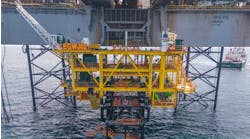Communications industry sets new products for specific offshore applications
Though the disastrous effects of the Gulf of Mexico hurricanes of 2005 on the whole of the middle US Gulf Coast are still incalculable, the destruction they wrought upon just the offshore petroleum industry was the most severe in the industry’s history.
If the storms’ damage to offshore capital equipment and infrastructure - and the resulting protracted interruption in oil and gas production - taught offshore oilmen anything, it was that they still have not succeeded in learning a lesson that’s been drubbed into them time and again since the industry’s birth in the mid-1950s, i.e. you ignore or underestimate the potential damage caused by hurricanes and other natural disasters, but at your own peril.
Perhaps nowhere was this inconsistency more apparent than in the near-total loss of communications among practically all Gulf enterprise, both on land and offshore. For the most part, terrestrial, or landline, connections were compromised by storm surges and trapped high water. But then, satellite-based cellular telephone service - apparently accepted by many companies as an emergency backup - became severely overloaded, losing most of its connectivity for weeks afterward.
Offshore, a number of mobile drilling rigs and floating production facilities, evacuated long before, simply sank, while others were set adrift to meander through the heart of the offshore “watermelon” of concentrated rigs, platforms and other structures. A number of fixed production platforms simply disappeared and others were damaged irreparably, while subsea pipelines shifted and became entwined like so much kite string.
All the while, many of the companies who owned these facilities were left in the dark, literally, as to the condition of their equipment until they could arrange for aircraft flyovers or fast-vessel search missions. Even then, observers had to return to shore to report, since even airborne and ship-to-shore radio frequencies were clogged much of the time.
However, since it’s an ill wind indeed that doesn’t blow some good, the 2005 Gulf storms did teach the offshore industry a new lesson. Offshore communications - of all kinds, including voice, data, video, and others - must be available for all contingencies, be they natural or man-made. Communications equipment - for so long considered sensitive and subject to constant shutdowns - also must today be exceedingly reliable.
The following stories cover some of the latest communications systems and equipment that the telecom industry has developed for specific application in the offshore petroleum industry. Much of it is rugged, user-friendly and highly effective, lending considerable confidence to those offshore companies who use it today or will embrace it in the future.
Jay Schempf, Special Correspondent


